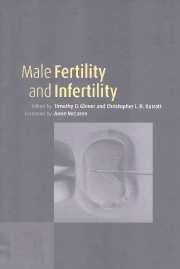Book contents
- Frontmatter
- Contents
- List of contributors
- Foreword by Anne McLaren, FRS
- Preface
- Acknowledgements
- Part 1 Biological perspectives
- Part 2 Implications of the new technologies
- 8 ICSI: the revolution and the portents
- 9 The genetic basis of male infertility
- 10 The treatment of azoospermia with surgery and ICSI
- 11 The challenge of asthenozoospermia
- 12 Molecular techniques for the diagnosis of inherited disorders and male reproductive malfunction
- 13 Gazing into the crystal ball: future diagnosis and management in andrology
- Index
11 - The challenge of asthenozoospermia
from Part 2 - Implications of the new technologies
Published online by Cambridge University Press: 09 August 2009
- Frontmatter
- Contents
- List of contributors
- Foreword by Anne McLaren, FRS
- Preface
- Acknowledgements
- Part 1 Biological perspectives
- Part 2 Implications of the new technologies
- 8 ICSI: the revolution and the portents
- 9 The genetic basis of male infertility
- 10 The treatment of azoospermia with surgery and ICSI
- 11 The challenge of asthenozoospermia
- 12 Molecular techniques for the diagnosis of inherited disorders and male reproductive malfunction
- 13 Gazing into the crystal ball: future diagnosis and management in andrology
- Index
Summary
Introduction
In this review three challenges posed by asthenozoospermia are considered. First, the development of a physiologically and clinically based definition of the condition. Secondly, the identification of the molecular pathology underlying poor sperm motility and, finally, the clinical management of men with asthenozoospermia.
Challenge 1: A physiologically based definition
The first challenge of asthenozoospermia is to decide what precisely it means. The World Health Organization (1992) defined it as ‘Fewer than 50% spermatozoa with forward progression or fewer than 25% with category ‘a’ movement [rapid progressive motility], but this is a largely qualitative statement. A better definition would be based on objective measurements of sperm concentration and of motility characteristics and their combined relationship to sperm physiology and to clinical outcome. Not all laboratories can make such measurements, but the existence of quantitative criteria would provide a ‘Gold Standard’ against which more subjective methods could be judged. To develop such definitions, we will need to know what attributes of sperm motility are the most important for predicting fertility under different circumstances. What is required for natural fertility, for instance, may be less important after intra-uterine insemination (IUI) and this may in turn require different attributes from in vitro fertilization (IVF). Once parameters have been selected, we must decide how they should be described.
- Type
- Chapter
- Information
- Male Fertility and Infertility , pp. 191 - 212Publisher: Cambridge University PressPrint publication year: 1999



